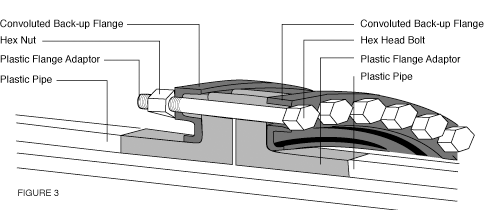Three critical factors have influenced the growth and acceptance of the IPP Deltaflex® designed flanges or back-up rings in the piping industry.
- National standards for flanges, such as ANSI B16.5 and AWWA C-207, were developed many years ago. This was long before the sophisticated computer analytical tools available today, which can be utilized to design flanges. As a result, IPP has shown that the standard flanges called out were either over-designed, in the case of ANSI, or not applicable for modern piping materials such as thermoplastics, as is the case for AWWA.
- Historically, engineers have been under the impression that the only method to reduce the cost of standard flanges was to make them thinner. As a result flange-sealing performance has suffered.
- Standard back-up flanges utilized on high density polyethylene (HDPE) piping stub-end applications were assumed to safely perform at the stated AWWA pressure ratings. IPP research has shown that the AWWA piping industry standards are not applicable to HDPE pipe.


 In order to make the backing ring selection process less confusing, IPP has designed its products in conjunction with the most commonly used SDR pipes in the industry. Our standard lines include SDR7 in sizes 1/2″ through 24″ and SDR11 in sizes 2″-47″ with many more to choose from, and all are designed with a safety factor of 2.
In order to make the backing ring selection process less confusing, IPP has designed its products in conjunction with the most commonly used SDR pipes in the industry. Our standard lines include SDR7 in sizes 1/2″ through 24″ and SDR11 in sizes 2″-47″ with many more to choose from, and all are designed with a safety factor of 2.